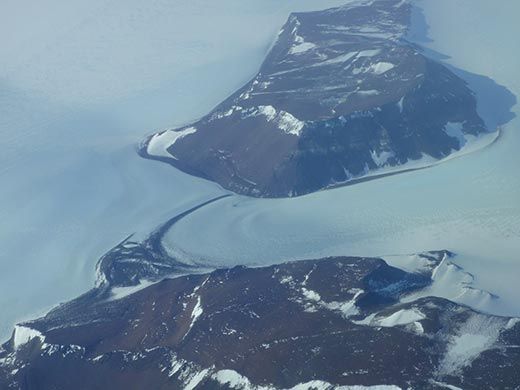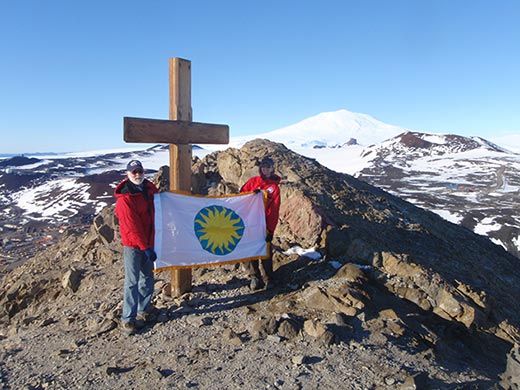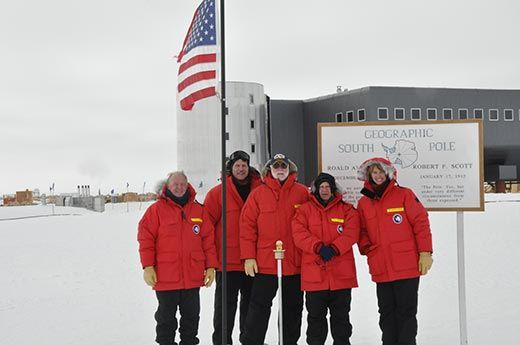Day 3: A Day at the South Pole
Flying over the paths trod by explorers before him, Secretary Clough arrives at the South Pole eager to meet the Smithsonian scientists working there
/https://tf-cmsv2-smithsonianmag-media.s3.amazonaws.com/filer/Clough-atop-Observation-Point-631.jpg)
Rising early at around 5 a.m., I get moving and go outside to walk off the sleep. Before me lies a different and beautiful world. It is crisp, the air tingles on the skin and the sun, which is not rising because it did not set, is low on the horizon, emanating a rose-tinted light that falls gently on a white landscape. Across McMurdo Sound the mountains rise mute and serene. Mount Erebus looms behind me with its white cloak of snow and ice disguising the seething magmatic heat that lies within. In this seemingly quiet and motionless setting, it is hard to believe that the earth and its covering of ice are on the move.
Slowly and almost imperceptibly, the sea ice moves in different directions depending on how close to shore it lies and which current is dominant. At this time of year, sea ice can be thin and often breaks into thousands of pieces that move along together like cattle on a drive. The great ice sheets lying on the continent are thicker and move at their own pace on a course dictated by topography and gravity. While this movement is imperceptible to us, it can be detected in the form of impressive pressure ridges that snake across the ice of the Sound where the plates have come together in a contest of wills. The forces between the ice sheets are enormous and result in buckling at the edges that form pressure ridges with ice piled tens of feet high. These ridges create openings in the ice that Stellars seals use to surface in order to sun themselves and rest from a day’s fishing. Dozens of these creatures can be seen in groups on the ice as I survey the scene. Humans are newcomers to this part of the world, and of the species who live here we are the least adapted and the least attuned to the ways of it.
After a hearty breakfast, I check e-mail to make sure yesterday’s journal, finished late last night, made it to the Castle. The answer—mostly. Seems I tried to send too many pictures at once and they did not get through. Panic! I have 15 minutes to rectify this before we leave to board the plane. I go to work on a computer that seems agonizingly slow. “Come on, come on, read the dadgum file!” (I actually said something a little more earthy.) Finally, the system absorbs the last picture and I rush to put on the final layer of the cold gear for the trip to the South Pole.
We are driven back to the Pegasus Airport and board a Hercules C130 that is even more spartan than the C17 we flew in on. The Hercules, the workhorse for the Air Force around the world, is a marvelous airplane that can land and take off on short runways in difficult conditions. Ours is outfitted with skis so it can slalom along on the ice to take off. I visit with the pilots in the cockpit after we are off the ground and they are reassuring by virtue of their confidence and professionalism. These are the men and women of the New York National Guard who have been at this job for many years. They understand how to navigate in a part of the world where latitude and longitude are almost meaningless because they all converge at the Pole. So they invent their own grid to help guide them, assisted by GPS technology.
Flying at 25,000 feet we can see the massive ice sheets and glaciers below us as well as the upper reaches of mountains that are high enough to rise out of the thousands of feet of ice that are found here. We are following largely a north-by-northwest route from McMurdo to the Pole, roughly paralleling the route that Robert Scott used on his ill-fated run to the Pole. Scott, the hardnosed British soldier, had his team pull their own sleds without the help of dogs, foot by agonizing foot over crevasses and pressure ridges on the glaciers. I am amazed as I look down on the Beardmore Glacier—the largest in the world—and its infinite crevasse field. When one considers that Scott was also determined to take along scientific collections, including rocks, it is impressive that he got as far as he did. Unfortunately for Scott, however, the Norwegian explorer Roald Amundsen reached the Pole before him using skills he had learned from native people in the Arctic.
One is struck by the fact that the world’s largest glaciers exist in a land where there is so little precipitation. The glaciers have been created over eons, growing little by little each year because that “little by little” never melts. Finally, they grow so massive that gravity eases the weight of the ice downhill through valleys that the glaciers carve wider by bulldozing rock and scraping and gouging it from the mountains. The detritus of the rock grinding is seen at the edges of the glaciers as dark bands.
Our Hercules lands us at the South Pole Station around 11:30 a.m. At the Pole the horizon is flat and the sun simply orbits in a circle around a line drawn straight up from the Pole. Fortunately for us, the weather is good. Although it is 25 below, it is not unpleasant because of the lack of wind. We walk to the headquarters facility and in doing so have to walk up three flights of stairs. Remember the warning we were given about the altitude? Although I took the altitude sickness pills we were issued in Christchurch, climbing the stairs I can feel the muscles pull deeply and the air seems too thin.
The facilities at the station are relatively new and built to serve the science and the people who conduct it. About 250 people are here in the summer, which ends three weeks from now in Antarctica. Only a skeleton crew will remain through the long, dark winter to maintain the scientific equipment and facilities infrastructure. In the main conference room of the large headquarters building we are given an overview of the science at the station and its support systems. A few questions elicit some interesting answers. For example, the buildings at the Pole rest on a huge ice sheet that is moving at an estimated speed of 30 feet per year. Each year the buildings travel along for the ride and shift to new locations. The water we are drinking tastes wonderful and we learn that it is melted water from ice far below the ground that was formed perhaps 2,500 years ago.
Our plan is to take a tour of most of the many impressive facilities at the Pole. But as we step outside it is all too apparent the weather has turned with a hard wind blowing and ice crystals falling from low clouds. Finally it seems cold enough to make you feel like you are really at the South Pole. I am told that with the wind chill, it feels like 35 degrees below zero—now that’s more like it! It also is exciting to see what is termed a “sun dog”—a beam of light that partially or fully rings the faint sun obscured by the clouds. Our sun dog is a complete halo around the sun and adds an element of beauty to an otherwise gray sky. The turning weather speeds up our tour since it seems the winds and blowing ice dictate that the last plane, which was to have flown up from McMurdo, is unlikely to make it and we will return on one that has recently arrived.
Our first stop is a telescope that records evidence of the Big Bang and may provide clues as to the cause of it. The team working on this new device is from the University of Chicago under the direction of Dr. John Carlson, who explains why the telescope is located at the Pole—conditions are the driest on Earth and the telescope can look straight up at the sky with no curvature of the Earth involved. Smithsonian scientists are involved with a number of other astronomical devices in the area and I ran into one of our colleagues from the Harvard/Smithsonian Center for Astrophysics, Harvard Professor John Kovac. We turn to a project called “Ice Cube,” whose principal investigator is Dr. Francis Halzen of the University of Wisconsin. Holes are being drilled a mile and a half into the ice sheet to house instruments that will detect the signature of neutrinos that stray from space into our atmosphere and onto the Earth’s surface, particularly in the Antarctic where they strike ice and give off a ghostly glow. These tiny messengers from millions of miles away carry information about the formation of the universe. There are to be 80 vertical strings of some 4,800 detection modules, with most of these already complete. We watch as the last instruments of the season are lowered into the deep hole in the ice and are given the opportunity to autograph a detector’s protective shield. Dr. Halzen informs us these detectors may be in the ice for hundreds of years!
It is impressive not only to see the science of the South Pole but also to meet the people who work here and are rightfully proud of their contributions. Nothing is easy at the Pole, and everything has to be flown in. Equipment and buildings must be assembled and operated in incredibly cold conditions. It is about as difficult as it gets.
Our last stop of the day is at the South Pole itself, which is located near the headquarters building. Flags fly and there are plaques dedicated to Amundsen and Scott and their teams. We take some pictures but it has gotten even colder so no time is lost before we board the return flight to McMurdo and are on our way to base camp. Receding behind us is one of the most unique places in the world and I am glad to have lived to visit it.
Upon our return at about 6:30 p.m. we have some free time. The temperature is milder at McMurdo and the bright sun energizes me to climb to the top of Observation Point looking out over McMurdo Sound and the station. Members of Scott’s expedition team who remained at base camp would look for his return from the Pole from this point and it is capped by a wooden cross to commemorate Scott and the others who never returned. Kristina Johnson and I climb to the top for the panoramic view that is stunning at this time of day. To commemorate our climb, I have brought along a Smithsonian flag which we fly briefly at the summit. A fitting end for a wonderful day.
Planning Your Next Trip?
Explore great travel deals
Smithsonian magazine participates in affiliate link advertising programs. If you purchase an item through these links, we receive a commission.
/https://tf-cmsv2-smithsonianmag-media.s3.amazonaws.com/accounts/headshot/wayne-clough-240.png)



/https://tf-cmsv2-smithsonianmag-media.s3.amazonaws.com/accounts/headshot/wayne-clough-240.png)